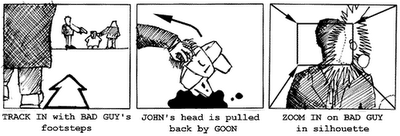
Arrows - Suppose the camera is tracking in, following a bad guy's footsteps. Draw in an arrow pointing into shot to show the camera's movement. Now the hero's head is pulled back by one of the bad guy's goons. Use an arrow to show the movement of the head being turned. What about a zoom in? From each corner draw in arrows pointing to the centre, draw in a new smaller frame to show the end of the zoom. Generally I try and use thick white arrows to show camera moves and thin black arrows to show objects moving.
The Floating Frame - What if you want to show the camera panning to show a cityscape, or following a character as they walk through an airport? There's two options here: 1) Illustrate one shot using more than one storyboard frame showing the key stages of the shot's movement across a number of frames or 2) Draw out the entire scene (e.g.. the horizon of a city) and place a frame on it with an arrow indicating the direction of movement.
Transitions - The storyboard can also include transitions in your film. Write these in the gaps between the frames e.g.. DISSOLVE TO :
No comments:
Post a Comment